Stocks Are Still Down from 2008
Stock-Markets / Stocks Bear Market Apr 01, 2010 - 03:12 AM GMTBy: Graham_Summers
 Yesterday we pointed out how Gold and the US’s attaining of debt saturation have rendered Bernanke and the world central bankers’ attempts to re-flate the US economy and markets meaningless. Indeed, with stocks down 80%+ (when denominated in non-paper currency) and ever new $1 in debt issuance now acting as a drag on US productivity (incomes have dropped to the point that we can no longer finance our debt) any talk of recovery or bull markets is myopic at best.
Yesterday we pointed out how Gold and the US’s attaining of debt saturation have rendered Bernanke and the world central bankers’ attempts to re-flate the US economy and markets meaningless. Indeed, with stocks down 80%+ (when denominated in non-paper currency) and ever new $1 in debt issuance now acting as a drag on US productivity (incomes have dropped to the point that we can no longer finance our debt) any talk of recovery or bull markets is myopic at best.
As if that’s not bad enough, today I want to point out that the S&P 500, when priced in Gold, is in fact LOWER than it was during the Crash of 2008. Hard to believe, but once you take paper money out of the equation, stocks are still down roughly 20-30%.
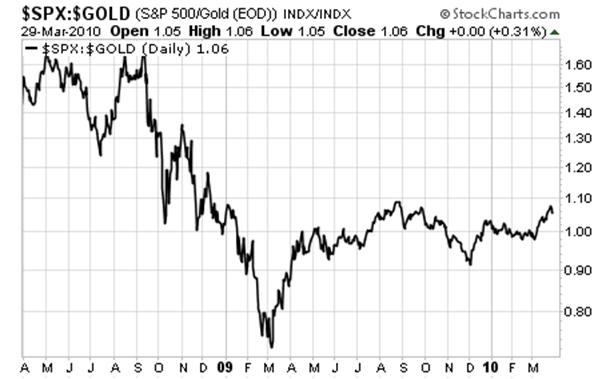
I know that once again, people will argue with me that measuring stocks in Gold is meaningless since we use the US Dollar, NOT Gold to purchase stocks. However, this argument renders itself moot since measuring stocks in Dollars isn’t any better since the Dollar’s value (purchasing power) fluctuates over time. Indeed, with the Dollar down some 10% over the same time period (late 2008-to the present) measuring stocks in Dollars is like measuring your height with a shrinking ruler.
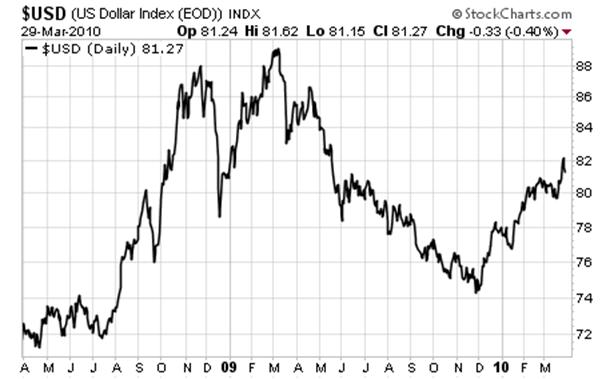
Bottomline: we’ve got to denominate stocks in something. Personally I prefer Gold because it doesn’t have a “print” button associated with it. Case in point, when you denominate stocks in the Euro (another flawed paper currency) they look to have recovered most of their 2008 losses:

However, priced in Copper (can’t be printed) stocks are back at 2008 levels.
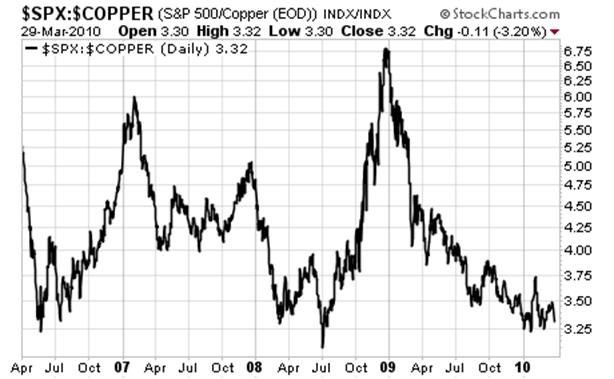
This in plain terms tells us that much of the gains seen in stocks is coming from loose money/ money printing. Stocks appear to be up, but in actuality have simply profited from currency devaluation (which now is occurring across the board). This is even clear when we price stocks in some of the STRONG currencies associated with hard assets (Canada Dollar, Australian Dollar).
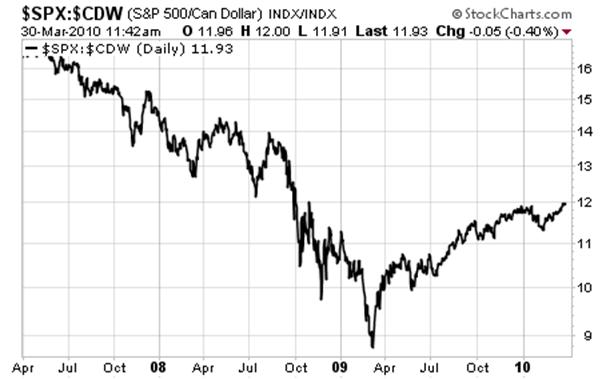
As you can see, priced in resource rich Canada’s currency, stocks are roughly back to October 2008 levels. Their results are even more feeble when you price them in Australian Dollars:
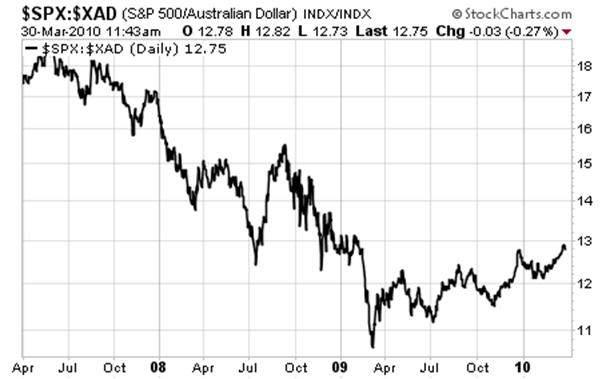
My main point is this: in a paper world you need to measure stocks in something aside from a crumbling currency to estimate real wealth generation. When we price stocks in “printer friendly” currencies the performance looks grand. But priced in “things” (Gold, Copper, even stronger paper currencies) the performance is muted if not weak. This, overall, indicates that hard assets have been a better storehouse of value in the last two years (despite the volatility). It also hammers home the point of yesterday’s essay: that you CANNOT print your way to real wealth.
Good Investing!
Graham Summers
PS. I’ve put together a FREE Special Report detailing THREE investments that will explode when stocks start to collapse again. I call it Financial Crisis “Round Two” Survival Kit. These investments will not only help to protect your portfolio from the coming carnage, they’ll can also show you enormous profits.
Swing by www.gainspainscapital.com/roundtwo.html to pick up a FREE copy today!
Graham Summers: Graham is Senior Market Strategist at OmniSans Research. He is co-editor of Gain, Pains, and Capital, OmniSans Research’s FREE daily e-letter covering the equity, commodity, currency, and real estate markets.
Graham also writes Private Wealth Advisory, a monthly investment advisory focusing on the most lucrative investment opportunities the financial markets have to offer. Graham understands the big picture from both a macro-economic and capital in/outflow perspective. He translates his understanding into finding trends and undervalued investment opportunities months before the markets catch on: the Private Wealth Advisory portfolio has outperformed the S&P 500 three of the last five years, including a 7% return in 2008 vs. a 37% loss for the S&P 500.
Previously, Graham worked as a Senior Financial Analyst covering global markets for several investment firms in the Mid-Atlantic region. He’s lived and performed research in Europe, Asia, the Middle East, and the United States.
© 2010 Copyright Graham Summers - All Rights Reserved
Disclaimer: The above is a matter of opinion provided for general information purposes only and is not intended as investment advice. Information and analysis above are derived from sources and utilising methods believed to be reliable, but we cannot accept responsibility for any losses you may incur as a result of this analysis. Individuals should consult with their personal financial advisors.
Graham Summers Archive |
© 2005-2022 http://www.MarketOracle.co.uk - The Market Oracle is a FREE Daily Financial Markets Analysis & Forecasting online publication.



